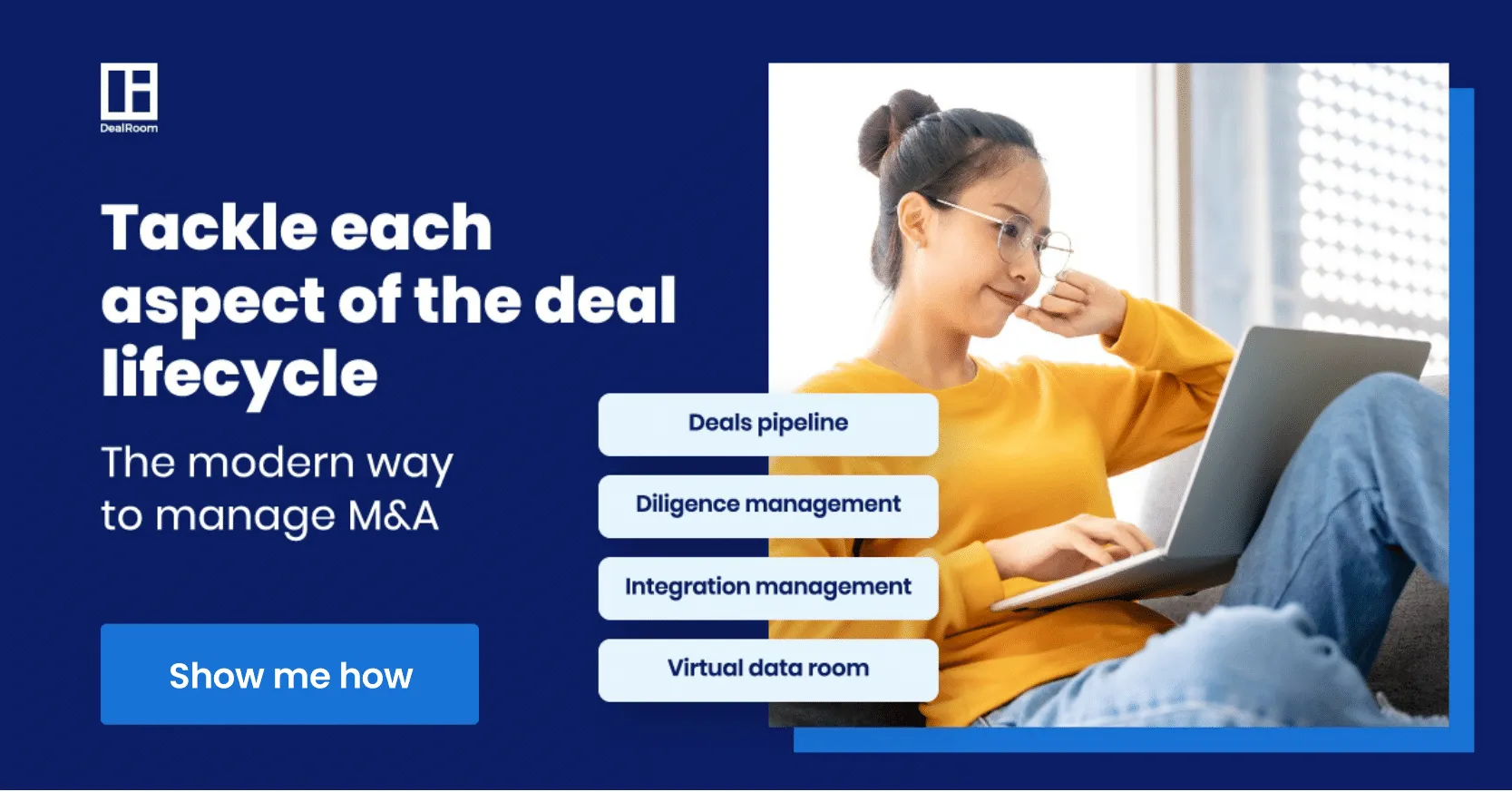The legal implications of M&A are almost as important as the financial implications.
From the moment a company makes its initial contact with a target, right through to closing the transaction (and sometimes even after) there are numerous legal matters that a firm must handle. Hence, it’s important when beginning an M&A journey that a company hires a competent M&A lawyer to avoid the existential threat of litigation.
DealRoom regularly helps teams organize M&A and legal processes and and below we look at what we believe to be 7 key legal aspects of the M&A process.
List of Key Legal Aspects of Mergers and Acquisitions
- Due Diligence
- Deal Structure
- Representations and Warranties
- Non-Competes and Non-Solicits
- Target Indemification
- Joint and Several Liability
- Closing Conditions
1. Due Diligence
Due diligence is top of every corporate M&A attorney’s to-do list. Covering all aspects of the target company, from its operations through to its intellectual property, a good legal counsel - equipped with strong due diligence technology - will be aware of the intricacies involved and what to look out for.
In this process, they meticulously evaluate various components including existing contracts, compliance with regulatory standards, intellectual property rights, ongoing or potential litigations, employment-related matters, environmental concerns, and even tools such as legal invoice software used by an organization for legal billing.
Their primary objective is to discern and highlight potential risks or liabilities that could impact the transaction, ensuring that no stone is left unturned, and crucially, to flag any concerns that might lead to future litigation.
2. Deal Structure
The term ‘deal structure’ tends to make people think of financial structures, earn outs and divisions between cash and equity.
The reality is, a deal structure is as much legal as it is financial.
For example, whatever structure is agreed to in the deal, important legal issues need to be considered, including shareholder approval, the tax consequences of the structure agreed to, transferability of liability, third-party contractual consent requirements, and foreign regulatory issues (if applicable).
Deciding whether to buy the company or just its assets (thus, not taking on any of its liabilities) is another consideration that corporate M&A lawyers will advise on.
3. Representations and Warranties
It is now standard for acquirers to include several representations and warranties in the terms of their transaction.
These typically aim to avoid the threat of litigation for the acquiring firm in issues such as
- compliance,
- tax,
- authority,
- capitalization,
- and material contracts.
This is no small matter - generally, breaches in any of these representations and warranties can result in indemnification claims from the acquirer - destroying value in the deal.
This can be a complex gray area, where even the most honest target company owner may leave themselves vulnerable on issues that they might not always have full awareness of.
Lawyers on the sell side will often try to push back against many of the representations and warranties on this basis.
4. Non-Competes and Non-Solicits
Non-competes and non-solicits are important legal clauses in practically all transactions, particularly in the services industries.
Suppose, for example, that a technology firm acquires a technology startup with some of Silicon Valley’s most talented software engineers.
Without a non-compete, what’s to stop the team members of this company jumping ship and beginning a copycat company straight after the sale of their startup?
Restrictions here should be reasonable in their time and scope, and include some consideration.
5. Target Indemnification
Target indemnification are hotly contested clauses in the closing conditions of M&A transactions.
Again, these are essentially clauses which seek to protect the acquiring company on the downside.
Say, in the case of fraud or or material misrepresentation on the part of the seller, the acquirer could include an indemnification clause that annuls the transaction and/or forces the seller to pay back a pre-agreed amount up to the value of the closing price.
6. Joint and Several Liability
Joint or several liability is an extension of the target indemnification issue.
It asks: Which of the target’s shareholders does indemnification apply to, and to what extent. In the case of joint liability, each of the target’s shareholders is fully liable for any future damages.
In the case of several liability, each of the target’s shareholders can be liable only to the extent that they are seen to have contributed to the damages (for example, the CFO would be responsible for misstatements in the company’s financial results, but not the CTO).
7. Closing Conditions
The conditions set out in the definitive agreement are themselves subject to closing conditions. As the name suggests, these are conditions that must be met in order for the transaction to close.
These tend to be the same across transactions and typically include board approval for the deal, the absence of any material changes to the company’s trading conditions, and of course, shareholder approval.
In the case of shareholder approval, acquirer’s often seek shareholder approval in excess of 80%, to avoid the complications that arise with hostile acquisitions (such as appraisal claims, for example).




















.png)
.webp)



.webp)
.webp)
.webp)





.png)
.png)
.png)
.svg)

.svg)
.png)
